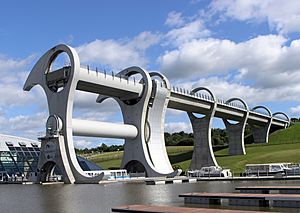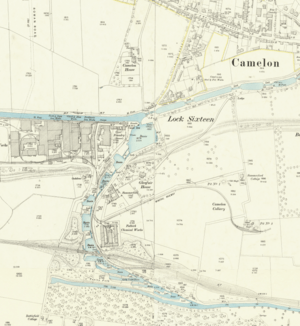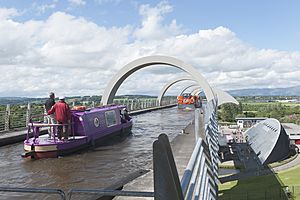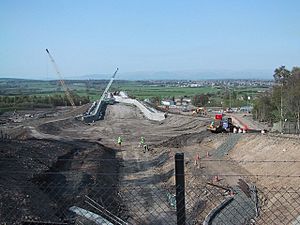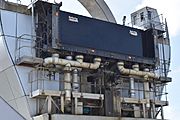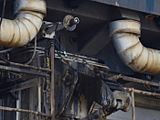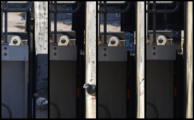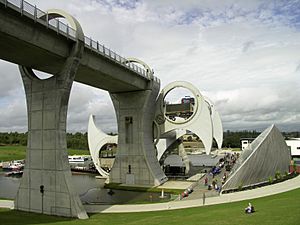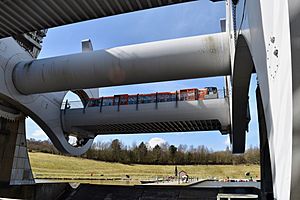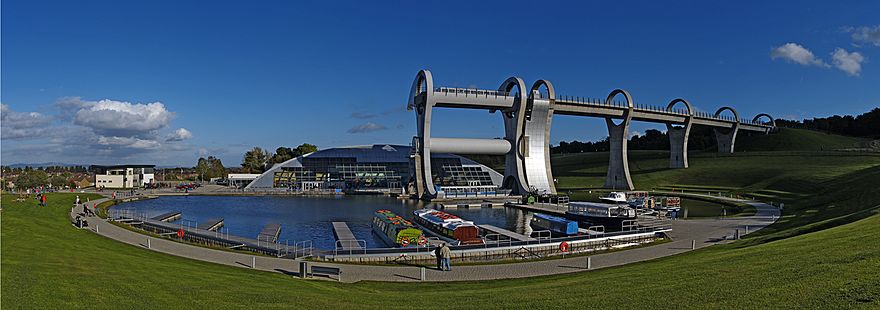Falkirk Wheel facts for kids
The Falkirk Wheel is an amazing rotating boat lift in central Scotland. It connects two important canals, the Forth and Clyde Canal and the Union Canal. This special lift is named after the town of Falkirk, where it is located. It was opened in 2002 and was the first time these two canals had been linked since the 1930s. It was a big part of a project called the Millennium Link.
This project aimed to bring central Scotland's canals back to life and reconnect cities like Glasgow and Edinburgh. Instead of building old-fashioned locks, planners decided to create a modern and exciting landmark.
The wheel lifts boats up by about 24 meters (79 feet). But the Union Canal is still 11 meters (36 feet) higher than the aqueduct that meets the wheel. So, boats also go through two locks after leaving the wheel to reach the Union Canal. The Falkirk Wheel is the only rotating boat lift of its kind in the world. It's also one of only two working boat lifts in the United Kingdom.
Contents
History of the Wheel
Old Canal Link
Before the Falkirk Wheel, the two canals were connected by 11 locks. These locks helped boats move up or down a height difference of 35 meters (115 feet). It took a lot of water and almost a whole day for boats to get through all of them.
By the 1930s, these locks were no longer used and were taken apart. The Forth and Clyde Canal closed in 1962. By the mid-1970s, parts of the Union Canal were filled in or built over. In 1976, a plan was made to keep the remaining parts of the Forth and Clyde Canal open for boats.
The Idea for the Wheel
In 1993, the National Lottery started in the UK. It created the Millennium Commission to give money to special projects that would celebrate the year 2000. The rule was that the Commission would pay for no more than half of a project.
The British Waterways Board (BWB) had a plan to reopen the canal link. In 1995, they asked for money from the Millennium Commission. Their plan was to make the canals fully open for boats again. The whole project was expected to cost £78 million.
On February 14, 1997, the Commission agreed to give £32 million to the project. This was 42% of the total cost. The Falkirk Wheel itself and its basin were estimated to cost £17 million. The rest of the money came from the BWB, local councils, Scottish Enterprise, and other groups.
Designing the Wheel
The first design for the wheel looked like a Ferris wheel with four cabins. But everyone agreed it wasn't special enough. So, a team of architects and engineers from British Waterways got together. Led by Tony Kettle, they created new ideas. The final design was a team effort between British Waterways, Arup, Butterley Engineering, and RMJM.
Tony Kettle even used his 8-year-old daughter's Lego to build models of the gear systems! The visitor center was designed by another architect, Paul Stallan.
The design of the Falkirk Wheel was inspired by many things. These included a double-headed Celtic axe, a ship's propeller, and the ribcage of a whale. Tony Kettle called the Wheel "a beautiful, organic flowing thing, like the spine of a fish." It was even called a "form of contemporary sculpture."
Models of the Falkirk Wheel have been shown in museums. Since 2007, the Wheel has been featured on the new £50 banknotes from the Bank of Scotland. These notes celebrate Scottish engineering.
Building the Wheel
Work on the Falkirk Wheel began in March 1999. More than 1,000 people helped build the wheel. It was designed to last for at least 120 years.
The wheel was first built and put together at a factory in Ripley, Derbyshire. Then, in 2001, it was taken apart and moved on 35 lorries to Falkirk. There, it was put back together in five large sections and lifted into place. Building the canal also involved digging out a huge amount of earth. They built a 160-meter (525 feet) long canal tunnel, aqueducts, locks, and bridges.
Building Challenges
The land where the wheel was built had been used for mining and other industries. This meant the ground was not very stable. So, deep foundations were needed. They used 30 concrete piles, each 22 meters (72 feet) long, that went down to the solid rock.
Because the wheel turns in different directions, some parts experience changing stress. To prevent cracks, sections were bolted together instead of welded. Over 14,000 bolts and 45,000 bolt holes were used!
The aqueduct, which carries the canal, was also very difficult to build. Original plans had the canal going straight through the ancient Antonine Wall. But this was changed to include two locks and a tunnel under the wall instead.
Opening Day

On May 24, 2002, Queen Elizabeth II officially opened the Falkirk Wheel. This was part of her Golden Jubilee celebrations. The opening was delayed by a month because of flooding.
How the Wheel Works
Its Structure
The wheel is 35 meters (115 feet) wide. It has two arms that look like a double-headed axe. These arms extend 15 meters (49 feet) from a central axle. Two large water-filled containers, called caissons or gondolas, are fitted between the ends of the arms. These caissons are opposite each other.
Each caisson can hold 250,000 liters (66,000 US gallons) of water. Together, the caissons always carry a total weight of 500 tonnes (about 550 US tons) of water and boats. The caissons themselves each weigh 50 tonnes (55 US tons). It's very important to keep the water levels balanced in each caisson. This is because, according to Archimedes' principle, a floating boat pushes out its own weight in water. So, when a boat enters, the same weight of water leaves. This keeps the total weight balanced.
A computer system makes sure the water levels are kept very precise. It only takes 22.5 kilowatts (30 horsepower) to power the ten hydraulic motors that turn the wheel. This is about the same energy as boiling eight kettles of water!
Each caisson is 6.5 meters (21 feet) wide. They can hold up to four 20-meter (66 feet) long canal boats. The wheel lifts or lowers boats by 24 meters (79 feet). Then, two more locks help boats move another 11 meters (36 feet).
Watertight Doors
The wheel has special watertight doors at each end of the caissons. These doors match up with doors on the upper structure and lower dock pit. Because there isn't much space, the doors lift straight up from the bottom of the caisson.
When the wheel stops, the doors are sealed. Pins and clamps hold the caissons in place. A special U-shaped seal on the upper aqueduct door extends to meet the caisson door. Water is then pumped into the small gap between them to make the pressure equal. Once the water levels are the same, the doors open, and boats can pass through. The process is reversed when the boats are ready to leave.
- Doors, locking mechanisms, and seals
Engine Room
The machinery that drives the wheel is located inside the last pillar of the aqueduct. This area has seven rooms connected by ladders.
The ground floor holds the transformers that power the wheel. The first floor has a backup generator. The second floor has two hydraulic pumps. These pumps power the ten hydraulic motors in the room above. These motors turn the central axle and also act as brakes. Each motor has a gear system that slows down the rotation speed.
How the Caissons Stay Level
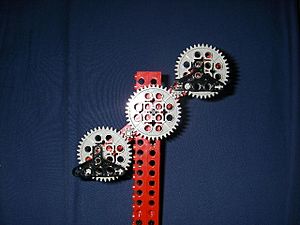
The caissons need to stay perfectly level as the wheel turns. Small wheels on each end of the caissons run on rails inside the arms. A clever gear system makes sure they stay level.
There are three large gears and two smaller gears. The large central gear is fixed and doesn't rotate. The two smaller gears are attached to the arms of the wheel. As the motors turn the central axle, the arms swing. The small gears engage with the fixed central gear, which makes the small gears spin. These small gears then turn the large ring gears on the ends of the caissons. This makes the caissons rotate in the opposite direction to the wheel's arms, keeping them perfectly stable and level.
The Docking Pit
The docking pit is like a drydock. It's a special area at the bottom of the wheel that can be kept dry. When the wheel stops, boats can enter and exit the lower caisson without flooding the whole area. The space below the caisson is empty.
If there wasn't a docking pit, the lower caisson and parts of the wheel's arms would be underwater every time the wheel turned. The water would make the lower caisson float, making it much harder to turn the wheel.
Visitor Centre
There is a visitor center on the east side of the lower basin. You can take boat trips on the wheel, which usually leave about once an hour. Since the wheel opened, millions of people have visited, and many have taken a boat trip. Around 400,000 people visit the wheel every year.
Media Mentions
The Falkirk Wheel has been shown on the Smithsonian Channel in the United States several times. It was featured in "Aerial Britain" in 2017, and in "How Did They Build That?" in 2021.
See also
 In Spanish: Rueda de Falkirk para niños
In Spanish: Rueda de Falkirk para niños


